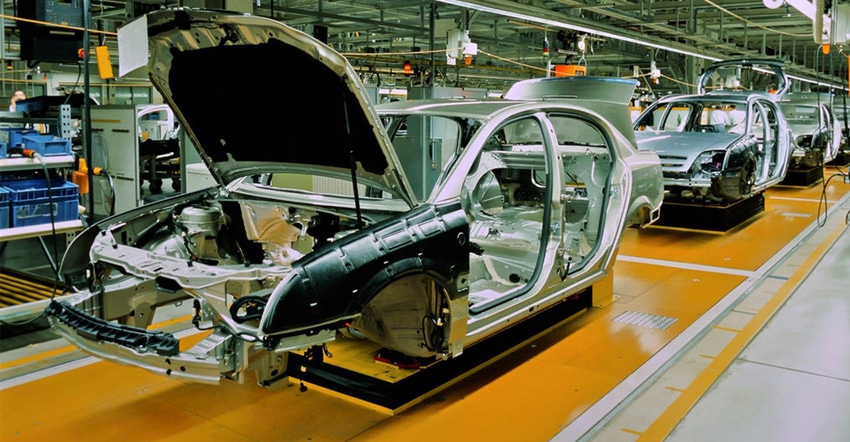
A global consortium of original equipment manufacturers (OEMs) and their suppliers have released a new guidance document demonstrating how the industry plans to advance environmental sustainability through the automotive supply chain.
The Suppliers Partnership for the Environment (SP) is a collaborative forum that brings together global automotive manufacturers, those in the supply chain, the U.S. Environmental Protection Agency (EPA) and other government bodies to synergize on a vision for positive environmental impact. The newest project SP members produced is the guidance document, “Sustainable Packaging Specification Recommendations for Automotive Manufacturing Operations.”
The recommendations in the report discuss “opportunities to minimize automotive packaging waste and address potential barriers to recyclability in the design phase, based on proven best practices that have been implemented by industry environmental sustainability leaders.”
Sophia Borroni-Bird sustainability lead at General Motors (GM), speaks about the benefits of the partnership, saying, “the collaboration drives down the cost of the materials. More importantly, creating a circular economy and addressing climate change can’t be done in a vacuum.”
GM has been a member of SP for years, alongside Call2Recycle, Covanta, Audi Mexico, Ford Motor Company, Henkel, Honda North America, Li-Cycle, TerraCycle, Waste Management and others.
“The collaborative platform has allowed trust and relationships to be built over time,” Borroni-Bird says.
When she formally joined the group in 2019, Borroni-Bird brainstormed with other OEM representatives to gauge interest in the formation of a group focused on sustainable materials. The Materials Efficiency Working Group (MEWG) was the result of the discussions.
“The process involved developing common definitions, a mission, and a short-term timeline,” she explains. “We started by only have the OEMs and then quickly realized the importance of extending the group to include suppliers. Since Q4 2019, we have outlined a mission, collected supplier survey feedback, and received proposals on methods to increase sustainable content in common components as well as finalize this packaging initiative to encourage sustainable packaging across the industry.”
The original document, developed by John Bradburn, on behalf of SP member company ERA Environmental Management Solutions, allows OEMs to take a collaborative approach to solve some of the biggest challenges and address potential barriers in automotive packaging such as logistics.
Bradburn says, “this project is about companies working together through SP to share knowledge and lessons learned over many years of work to minimize waste across the automotive industry and promoting the thinking and action that is needed to tackle packaging waste minimization and pave the way for others to follow the same path.”
The first recommendation provides a backbone for the remaining guidance, stating “when building business cases for packaging design and logistics, include and communicate to procurement/purchasing/supply chain managers a total enterprise financial scope that considers all corporate goals and strategies including health, safety and the environment.”
Sustainability is an integral component throughout the document, explaining how automotive manufacturers can implement it in the value chain, including:
Whenever possible, source parts, modules and other products using returnable packaging and base this decision on lifecycle factors.
Avoid using foams in packages that include spacers and dunnage if possible, as most foams (polystyrene, polyurethane and other thermoset products) are difficult to recycle.
If a foam packaging product is sourced, expanded polypropylene (EPP) may be more recyclable than other foam options.
Combination packaging (specifically incorporating multiple materials) should be avoided whenever possible.
Pallet and container separation ease improves reuse and recycling potential.
Avoid using metal clips on plastic banding.
Avoid using metal brackets and wood to reinforce cardboard/OCC boxes.
Whenever possible, avoid one-time use packaging and assembly aids.
Plastic corrugate, which many times is polypropylene, should not be sourced with mixed plastics or metal fasteners unless material is intended for reuse
LDPE plastic bags and bubble wrap and other film can be reused or baled and placed into a plant recyclable film program.
Use of expanding polyurethane foam in packages should be avoided, especially when formed within plastic bags
Wooden crates, even for small batch shipping use, should be designed with ease of disassembly for reuse and/or shredding for recyclability in mind.
Over time, the “participation and engagement from the suppliers, especially those that are commonly shared amongst the OEMs, provides the coordinated savings of larger-scale positive actions,” says Mark Yamauchi, Toyota Motor North America sustainability manager.
Going forward, each automotive manufacturer will adapt the guidelines as appropriate and develop its own set of metrics to measure results. “Thus, it is anticipated that it may be difficult to establish common analytics,” Yamauchi says. “Success may end up be gauged anecdotally.”
About the Author(s)
You May Also Like




